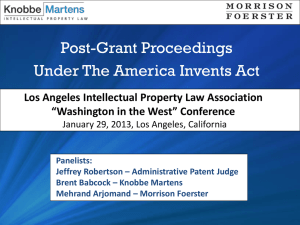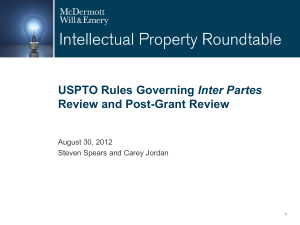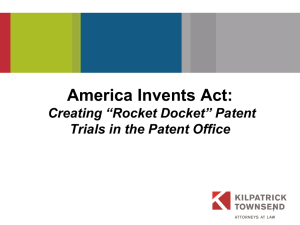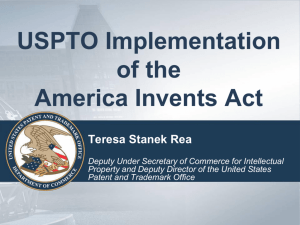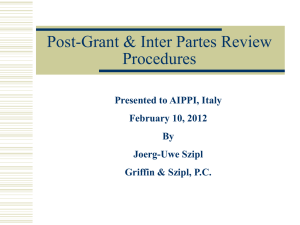What In-house Counsel Should be Doing Now to Get Ready for the
advertisement
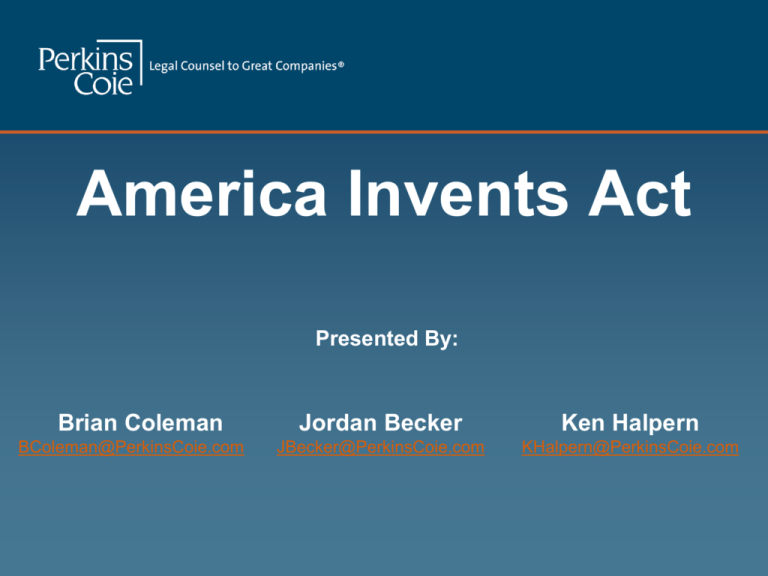
America Invents Act
Presented By:
Brian Coleman
BColeman@PerkinsCoie.com
Jordan Becker
Ken Halpern
JBecker@PerkinsCoie.com
KHalpern@PerkinsCoie.com
AIA SEC. 3: First Inventor to File
Old Regime: First-to-Invent
Conception and Diligent Reduction to Practice mattered,
giving inventor a "priority date" of conception
One year grace period from any public disclosure
First to file had prima facie priority, but
Swearing behind could eliminate certain references
Interference proceeding determined first to invent facts, including
conception and reduction
Any application with an effective filing date prior to
March 16, 2013 falls under first to invent -- first to invent
remains with us for some time
New Regime: First-to-File
Filing determines priority (i.e., the inventor entitled to a patent
is the first to file, NOT first to invent)
March 16, 2013 Applicable to any application with an effective
filing date on or after March 16, 2013 – Note long tail for first
to invent rules (e.g., March 15, 2033)
Personal grace period but no grace period as to independent
third party disclosures
Derivation concept becomes important, interference
proceedings eliminated
Complete rewrite of 102 prior art definitions and exceptions
Prior Art 102(a)
102(a)(1)
patented
described in a printed publication
Public use
On sale
Otherwise available to the public – does this mean no "secret"
prior art??
102(a)(2)
Described in a U.S. patent, or a published or deemed published
application
Names another inventor
Effectively filed before the effective filing date of the claimed
invention
Personal Grace Period 102(b)(1)
Grace period of one year preceding effective
filing date
Inventor priority not extinguished by:
Disclosures by or derived from the inventor, made within
one year
Disclosures made within one year by others but after an
earlier disclosure by inventor
Overcoming Prior Art by Removal
Patent and Application Art is removed when:
Subject matter was derived from inventor; or
Subject matter was publicly disclosed by inventor (or
derivers) prior to effective filing date of art; or
Subject matter disclosed and claimed invention
commonly owned or subject to common duty of
assignment, not later than effective filing date of
claimed invention
Derivation Proceeding
Patent applicant files a petition for a derivation proceeding
A petition for a derivation proceeding "may be filed only within the 1-year
period beginning on the date of the first publication of a claim to an
invention that is the same or substantially the same as the earlier
application's claim to the invention."
The petition must set forth with particularity the basis for finding that an
inventor named in the earlier application derived the claimed invention from
an inventor in the petitioner's application, and the petition must be
supported by “substantial evidence” as decided by the new PTAB.
Director's determination whether to institute a derivation proceeding shall be
final and nonappealable
PTAB determines whether derivation occurred
PTAB may correct inventorship of any patent or application at issue
Parties may settle issues themselves, subject to review of PTAB
Narrow discovery allowed during proceeding
Deposition of anyone signing an affidavit or declaration
What is otherwise necessary in the interest of justice
Take Away
File with urgency – same as it always was
Good record keeping still important, but disclosure
history now more important than proof of conception and
reduction
Keep the March 16, 2013 date in mind, consider filing
prior to
Disclosure to establish your own priority and create prior
art for others – maybe
Disclosure not clearly defined by AIA
Monitor patents and published applications for derivation
concerns
Post-Grant Proceedings
Patent Post-Grant Proceedings
"Post-grant review proceedings" as defined in AIA Sec. 6
includes:
Post-grant review (New)
Inter partes review (New)
Citation of Prior Art and Written Statements (New)
Other post-grant proceedings:
Ex parte reexamination (substantively unchanged, but cost
increasing from $2,250 to $17,750 (proposed))
Supplemental examination (New)
Reissue ('lack of deceptive intent' no longer required)
High Level Comparison
Proceeding
Threshold
Basis
Estoppel
Post-Grant
Review
More likely than not that at least
one claim is unpatentable
Any ground
(incl. product as prior
art, prior use or sale)
Raised or
reasonably
could have
raised
Current Inter Partes
Reexam (to be
phased out)
Reasonable likelihood petitioner
will prevail on at least one claim
(was SNQ prior to 9/16/2011)
Patents/printed
publications only
Could have
raised (but not
for ITC)
Inter Partes Review
Reasonable likelihood petitioner
will prevail on at least one claim
Patents/printed
publications only
Raised or
reasonably
could have
raised (incl. ITC)
Ex Parte
Reexamination
SNQ
Patents/printed
publications only
N/A
Supplemental
Examination
SNQ
Any information
N/A
Post-Grant Review (PGR) (1)
AIA Sec. 6, §§321-329, "effective" September 16, 2012,
but . . .
Only applicable to patents having priority date on or
after March 16, 2013 (AIA § 3(n)(1))
Not practically usable until at least late 2014 or 2015
Exception: Covered business method patents -- any priority
date, but only if have been charged with infringement Third
parties only
Real-party in interest cannot remain anonymous
Time limit to request PGR: 9 months after issuance of
patent
Duration: PTO final determination within 1 year after
instituting PGR (+ up to 6-months extension for good
cause)
Post-Grant Review (PGR) (2)
Grounds of invalidity
Any ground of invalidity (not just patents or publications)
101, 102/103, 112 (except for best mode), double
patenting, etc.
Yes for product as prior art, prior use or sale
A novel or unsettled legal question that is important to
other patents or patent applications
Opportunity to creatively raise issues
Post-Grant Review (PGR) (3)
Threshold: More likely than not that at least one of the
challenged claims is unpatentable
Higher threshold than former SNQ threshold and new inter
partes standard (reasonable likelihood petitioner will prevail)
but no "new" question of patentability is required
Expected USPTO filing fee: > $40,000 (anecdotal)
Compare: Filing fee for EPO Opposition is about $1,000
Post-Grant Review (PGR) (4)
PGR barred if:
(1) petitioner already filed a civil action challenging validity of the same
patent
unless validity challenge was filed as counterclaim
(2) petition requests cancellation of a claim in a reissue patent that is
identical to or narrower than a claim in the original patent and the
deadline has passed for PGR of the original patent
Impact on civil actions
Automatic stay of DJ action filed on/after the filing of petition for PGR
(not granted!)
Lifted if patent owner sues for infringement or so requests
Preliminary injunction
If a civil action alleging infringement is filed within 3 months after issuance of
the patent, court may not stay consideration of patent owner’s motion for
preliminary injunction on the basis that a petition for PGR has been filed or
PGR has been instituted
Post-Grant Review (PGR) (5)
Estoppel (in absence of settlement):
Petitioner (or its privy) cannot re-assert any ground that petitioner raised
or reasonably could have raised in PGR in:
Another PTO proceeding (e.g., subsequent inter partes review)
District Court
ITC (unlike inter partes reexam)
"Reasonably could have raised" v. "Could have raised" for Inter Partes
Reexam:
slightly narrower scope of estoppel
Estoppel attaches upon final written decision by PTAB
Sooner than in inter partes reexam ("all appeals exhausted")
Intervening rights apply (like reissue and current reexam)
Post-Grant Review (PGR) (6)
More litigation-like than prosecution
Discovery available (e.g., depose witnesses) expensive!
Protective order and sanctions
Evidentiary standard: preponderance
Settlement possible by joint request
unlike current inter partes reexam
No estoppel to petitioner if settled
Next: Transitional Inter Partes Reexam
Not available after September 15, 2012
Limited to patents issued on applications filed on or after 11/29/99
(like old inter partes reexam)
Only major change: Higher threshold: Reasonable likelihood that
petitioner will prevail on at least one claim (no longer need SNQ)
An "old" question or issue can be raised
New opportunity for challenging patents
Estoppel applicable to subsequent civil action only (not ITC)
Any ground "raised or could have raised"
Next: New Inter Partes Review (IPR) (1)
AIA §§ 311-319, effective Sept. 16, 2012
Who can request?
Third party only: "a person who is not a owner of a patent"
Real party in interest must be identified
Applicable to all patents as of Sept. 16, 2012
Regardless of filing date, priority date or issue date
Compare to Inter Partes Reexam: only patents issued on
applications filed on or after 11/29/1999
Compare to PGR: only patents with a priority date on or after
3/16/2013
Bad news for some patent owners
Inter Partes Review (IPR) (2)
Time to file: After the later of:
(1) 9 months from issuance (or reissuance) of patent, or
(2) Termination of a PGR (Note: AIA simply says "a" PGR, so any on-going PGR
of the patent (e.g., by others) will prevent IPR filing
IPR barred if:
(1) petitioner already filed a civil action challenging validity of the same patent
unless validity challenge is counterclaim
(2) petition is > 1 year after petitioner is served with a complaint
A critical bar date for patent litigation defendants to monitor
Parties sued before 9/16/2012 should consider filing inter partes reexam request before
9/16/2012, to take advantage of transitional rules (e.g., no litigation bar, no estoppel in
ITC)
Automatic stay of any DJ action filed on/after the filing of IPR petition (not
granted!)
Lifted if patent owner sues for infringement or so requests
Inter Partes Review (IPR) (3)
Grounds of invalidity
Issues under Section 102 or 103 and
Only on the basis of patents or printed publications
Cannot use product as prior art, prior use or sale
IPR Threshold -- Reasonable likelihood petitioner will
prevail on at least one claim
Higher than previous inter partes threshold: SNQ
Lower (?) than new PGR threshold: "more likely than not that at
least one of the challenged claims is unpatentable"
No "new" question is required
Inter Partes Review (IPR) (4)
Estoppel (if no settlement):
Petitioner (or its privy) cannot re-assert a ground (prior art) that
petitioner raised or reasonably could have raised in PGR, in:
Applies in:
Any other PTO proceeding
District Court
ITC (unlike inter partes reexam)
Estoppel attaches at final written decision by PTAB (sooner than in inter
partes reexam: "all appeals exhausted")
Intervening rights apply
Inter Partes Review (IPR) (5)
More litigation-like proceeding
Discovery available (e.g., can depose witnesses)
Protective order and sanctions
Evidentiary standard: preponderance of the evidence
Settlement possible by joint request:
Unlike inter partes reexam
No estoppel to petitioner if settled
Inter Partes Review (IPR) (6)
Process
Patentee may file a preliminary response before PTO review (new)
PTO decides whether to institute IPR within 3 months from (1) filing of
patentee's preliminary response, or (2) last date for filing the preliminary
response
No appeal permissible
PTO final determination within 1 year after instituting IPR (+ up to 6months extension for good cause)
Patentee can amend/cancel claims and propose "a reasonable
number of substitute claims" for each challenged claim
1 motion for amendment as matter of right
Additional motions for amendments possible for (1) settlement when
jointly requested with petitioner, or (2) as permitted by regulations
prescribed by the Director
Can't enlarge scope of claims, no new matter
Appeal directly to Federal Circuit (but estoppel already takes effect)
Inter Partes Reexam vs. Inter Partes Review (IPR)
Inter Partes Reexam
(Before 9/16/2012)
Inter Partes Review
(From 9/16/2012)
Tribunal
Central Reexamination Unit
Patent Trial and Appeals Board
Timing for
filing
Any time during patent term
After the later of: 1) 9 months from grant, or
2) termination of PGR (barred if IPR
requested > 1 year after being sued)
Threshold
Reasonable likelihood petitioner
will prevail on at least 1 claim (was
SNQ until 9/16/2011)
Reasonable likelihood petitioner will prevail
on at least 1 claim
Duration
Open-ended
1 yr max (+ up to 6 mo. for cause)
Estoppel
Could have raised (but not for ITC)
Reasonably could have raised (including ITC)
Discovery
N/A
Allowed
Appeal
To BPAI, then Fed Circuit
Directly to Fed Circuit
Effect of D.Ct.
proceedings
No bar
Barred if already filed for DJ; barred if > 1yr
after being sued for infringement
26
Inter Partes Proceedings
File now rather than wait for new IPR
proceedings to become effective on 9/16/2012?
After 9/16/2012, new IPR may be unavailable to some
parties for some patents, due to new IPR's DJ bar
and 1-year infringement claim bar
Estoppel under current rules does not include ITC,
whereas estoppel under new IPR will.
Next: Supplemental Examination (1)
AIA § 257, effective September 16, 2012
For patent owner only (like reissue & ex parte reexam)
Available to all patents
Timing: Anytime during patent term (like reissue & ex
parte reexam)
Threshold: SNQ
Basis: Any information -- not limited to printed
publications and patents
So what does that mean?
Supplemental Examination (2)
Laundry time!
Patent cannot be held unenforceable based on conduct relating to
information considered, reconsidered, or corrected during supplemental
examination (note: AIA says 'unenforceable', not 'invalid')
But, only applies if reexam concluded before filing civil/ITC action
Patent owner must act early
Supplemental Examination (3)
Proposed USPTO fees:
$5,180 for Request + $16,120 for the ex parte reexam = $21,300
compared to $2,520 for current ex parte reexam
Procedures not nailed down -- Proposed rules just
published Jan. 2012.
Supplemental Examination (4)
Limitations
Can't cure existing allegations
an allegation pled with particularity in a civil action, or set
forth with particularity in a notice received by the patent
owner under section 505(j)(2)(B)(iv)(II) of the Federal Food,
Drug and Cosmetic Act (21 U.S.C. 355(j)(2)(B)(iv)(II)), before
the date of the supplemental examination
Fraud by patent owner
USPTO can cancel claims based on reexam
USPTO shall report to Attorney General
Patent Owner Considerations
Identify & fix errors early
Review (or have outside counsel review) pending patent applications for
problems/errors before issuance – make sure prosecution counsel uses a preissuance checklist
Much cheaper/easier to fix major problems before issuance than after
Review issued patents for problems/errors well before contemplating filing
a lawsuit, if possible.
If supplemental exam desired, request it early if contemplating
enforcement
For major defects:
Supplemental Examination (new)
To reap benefit, must wait until reexam concludes before suing
Expensive ($21,300 proposed)
Ex Parte Reexamination (same)
Limited to patents and printed publications
Expensive ($17,750 proposed)
Patent Challenger Considerations
Post-grant review: Challenger's silver bullet?
Short 9-month window -- Issues and disputes on legal front and market
activities may not sufficiently mature for parties to take action
Estoppel attaches earlier than inter partes review
Not effectively usable until probably 2014-2015 (except for business
method patents)
Likely to be very expensive (> $40K in USPTO fees)
Inter partes review more likely to be useful
Consider filing inter partes reexam before 9/16/2012 to preserve
inter partes option and/or to set up concurrent processing with a
later-filed IPR/ex parte reexam
Consider active monitoring of patent related filings
AIA Joinder Provision
(35 USC § 299)
Common Patent-in-Suit
Cannot Alone Form Basis
for Joinder
Former Law (Rule 20): Same T-or-O
AND Common Issue of Law or Fact
FRCP 20(a)(2) – Defendants may be joined in a single
action if…
(A) right to relief asserted "jointly, severally, or in the
alternative w/r/t or arising out of the same transaction,
occurrence, or series of transactions of occurrences;
AND"
(B) "any question of law or fact common to all
defendants will arise in the action"
Seems adequate to bar common-patent joinder but
wasn't, at least in E. D. Texas
35 USC § 299
"accused infringers may be joined in one action as defendants or
counterclaim defendants, or have their actions consolidated for trial, or
counterclaim defendants only if--
(1) any right to relief is asserted against the parties jointly, severally, or in
the alternative with respect to or arising out of the same transaction,
occurrence, or series of transactions or occurrences relating to the making,
using, importing into the United States, offering for sale, or selling of the
same accused product or process; and
(2) questions of fact common to all defendants or counterclaim defendants
will arise in the action
NOT "law or fact"
(b) ALLEGATIONS INSUFFICIENT FOR JOINDER.--For purposes of this
subsection, accused infringers may not be joined in one action as
defendants or counterclaim defendants, or have their actions consolidated
for trial, based solely on allegations that they each have infringed the patent
or patents in suit.
Expressly Passed to Overturn
E.D. Texas Case Law
"Section 299 legislatively abrogates the construction of Rule 20(a)
adopted in MyMail, Ltd. v. America Online, Inc., 223 F.R.D. 455
(E.D. Tex. 2004) [and other cited cases, all but one from Texas or
La.] effectively conforming these courts' jurisprudence to that
followed by a majority of jurisdictions. --112 H. Rpt. 98, at note 61
(June 1, 2011)
MyMail (Judge Davis, now Chief Judge!) had held that Rule 20's "
same transaction, occurrence, or series of transactions of
occurrences" requirement was met by a "logical relationship" among
the different accused products which could be "substantial similarity"
This still ignores "jointly, severally, or in the alternative," but Judge
Davis deemed the clear meaning of the statutory language
"hypertechnical."
Effect of § 299 on Plaintiff Behavior
Trends before the AIA were similar to 2010, with
the top 7 jurisdictions same, measured by
defendants and cases
BUT big DE jump before AIA, almost catching
Texas
DE outpaced ED Texas after AIA
Texas drops off to 40% annualized rate of
defendants in last quarter of 2011 compared to
2010 but could be anchor-defendant strategy,
TBD
2011 by Total Defendants (no FM)
January – September 15, 2011
By Total Cases (no FM)
Cases
Plaintiffs
Defendants
Defendants
per Case
Plaintiffs
per Case
Defendants
per Plaintiff
Eastern District of Texas
279
399
2785
10.0
1.4
7.0
District of Delaware
278
540
2014
7.2
1.9
3.7
Central District of California
213
346
820
3.8
1.6
2.4
Northern District of California
157
311
607
3.9
2.0
2.0
Northern District of Illinois
124
170
632
5.1
1.4
3.7
District of New Jersey
120
303
279
2.3
2.5
0.9
Southern District of New York
97
325
398
4.1
3.4
1.2
District of Minnesota
67
106
368
5.5
1.6
3.5
Eastern District of Virginia
58
71
199
3.4
1.2
2.8
Middle District of Florida
57
64
238
4.2
1.1
3.7
District
2011 by Total Cases (no FM)
Cases
Plaintiffs
Defendants
Defendants
per Case
Plaintiffs
per Case
Defendants
per Plaintiff
District of Delaware
484
911
2458
5.1
1.9
2.7
Eastern District of Texas
418
593
3163
7.6
1.4
5.3
Central District of California
324
510
1036
3.2
1.6
2.0
Northern District of California
225
403
771
3.4
1.8
1.9
Northern District of Illinois
214
293
790
3.7
1.4
2.7
District of New Jersey
180
458
384
2.1
2.5
0.8
Southern District of New York
151
425
640
4.2
2.8
1.5
District of Massachusetts
91
182
197
2.2
2.0
1.1
District of Minnesota
84
130
428
5.1
1.5
3.3
Middle District of Florida
82
99
275
3.4
1.2
2.8
District
September 16 – December 31, 2011
By Total Cases (no FM)
Cases
Plaintiffs
Defendants
Defendants
per Case
District of Delaware
206
371
444
2.2
1.8
1.2
Eastern District of Texas
139
194
378
2.7
1.4
1.9
Central District of California
111
164
216
1.9
1.5
1.3
Northern District of Illinois
90
123
158
1.8
1.4
1.3
Northern District of California
68
92
164
2.4
1.4
1.8
District of New Jersey
60
155
105
1.8
2.6
0.7
Southern District of New York
54
100
242
4.5
1.9
2.4
District of Massachusetts
41
80
65
1.6
2.0
0.8
Southern District of California
28
34
43
1.5
1.2
1.3
Southern District of Florida
27
50
47
1.7
1.9
0.9
District
Plaintiffs
per Case
Defendants
per Plaintiff
Delaware Goes Off the Charts
Through 9/15, DE far ahead of 2010 annualized pace (278 cases, 2014 defs
in 2011, vs. 255/884 for all of 2010, i.e., triple the rate of defendants sued)
Average 7.2 defendants per case, compared to 3.5 in 2010
Through 9/15, 8 plaintiffs, 4-5 firms, account for 52 cases, 1054 defendants
Even without these cases, DE is well ahead of its 2010 rate, still 3/2 rate
of defendants sued to that point. Without these cases, average 4.2 defs
per case
After 9/15, DE 206 cases, 444 defendants, annualized pace of 714 cases,
1539 defendants.
Average 2.2 defendants per case.
After 9/15, TX has 139 cases filed, 378 defendants, annualized pace of 482
cases, 1310 defendants
E.D. Texas Steady Through 9/15,
Large Decline in Defendants Sued After
Through 9/15, 279 cases, 2785 defendants
(annualized pace 392/3914), a small increase
over the 299/3879 in 2010
This was 11.5% of all 2011 cases filed to that point,
compared to 10% in 2010 // 24.4% of all defendants,
compared to "more than 25%"
Average 10 defendants per case
After 9/15, annualized pace of 482 cases, 1310
defendants, about exactly 1/3 the pace of
defendants compared to before 9/15
Average of 2.7 defendants per case
Huge Spike Overall the Week of 9/8-9/15
175 cases, 1787 defendants sued that
week
3660 cases, 14201 defendants in 2011
1/8 of all patent defendants sued last year
were sued in one week, between passage
and effective date of joinder provision
Why Delaware?
Was already 2d-most popular jurisdiction, and per
Lemley, highest "claimant" win rate among busy districts,
and highest trial rate by far (11.8%!) which suggests
unwillingness to grant SJ, relatively speedy time to
resolution of 1 year
Texas retirements (Ward, Everingham, Folsom from 9/10
to 6/11)
Judge Robinson signal on venue (6/11, reversed 12/11
in Link-A-Media)
9 mandamus reversals of EDTx transfer decisions from
'08-'10
Is E.D. Texas Over?
Defendants-sued rate dropped by 2/3 after the joinder provision
went into effect
BUT could be part of anchor-defendant strategy, publicly discussed
at Texas plaintiffs' bar event. Sue a Texas defendant, wait six
months, sue the other defendants, move to consolidate
35 USC § 299 prohibits joinder and consolidation for trial, but not
consolidation for pretrial proceedings
If this is the strategy, not enough time has passed to know if this is
occurring
At least some anecdotal evidence of this (Macrosolve)
Strategy
How would defendants nonetheless avoid
ending up in a massive multi-defendant
coordinated set of cases in the plaintiff's chosen
forum?
Consider key Federal Circuit precedents
assessing importance of forum's experience with
patents-in-suit as a factor in a transfer analysis
In re Verizon Business Network Services,
Inc. , 635 F.3d 559 (Fed. Cir. 2011)
Granted mandamus, ordered transfer from E. D. Texas
Texas court cited two efficiencies:
There had already been 2 years of litigation in the case at bar. The
docket reveals there had been a case management conference and an
order setting a trial date, an exchange of infringement and invalidity
contentions, and even a joint claim construction statement (though the
last was filed in March, 2011, after the mandamus petition had already
been briefed).
E.D. Texas had already considered the same patent in a prior suit, but
five years earlier.
Nonetheless, this could not overcome a “compelling showing of
transfer” based on the conventional factors of the convenience of
witnesses and location of evidence.
In re Vistaprint,
628 F3d 1342 (Fed. Cir., 2010)
Distinguished by In re Verizon
Court construed patent-in-suit in a prior case
Another co-pending action on the same patent
No party located in transferee venue, some
witnesses there
Convenience not necessarily favored over
considerations of judicial economy
In re Wyeth
406 Fed. Appx. 475 (Fed. Cir. 2010)
Denied writ
Action was pending for 17 months before
transfer was sought
Cited Vistaprint for notion that convenience
factors do not necessarily outweigh judicial
economy concerns
Key Considerations
Promptness of motion to transfer
Clear weight of convenience factors
Importance of substantive engagement with patents by
the Court
But can the plaintiffs afford to wait for this to happen?
Mandamus is extraordinary remedy, for which clear right
to relief must be shown under abuse of discretion
standard
Implications of AIA for Existing Case Law
Plaintiffs' workaround defeats the evident
purpose of the joinder statute
Effort to end phenomenon of massive
multidefendant suits whose only common thread
is the asserted patent(s), abuse of permissive
joinder
Treating "judicial economy" as established by a
common patent seems contrary to premise of
section 299
Possible Arguments
Statute’s premise that a common patent-in-suit is not a sufficient
basis for joinder arguably implies that a common patent alone does
not satisfy Rule 20’s requisite of a common issue of law or fact
Thus, a Markman hearing in one case should not be treated as
presumptively relevant to the issues in another case
Even if statute's purpose is understood as “avoiding confusion,” that still
implies a presumption that the issues from one defendant to the next
are distinct
At a minimum, the joinder statute suggests that a common patent
cannot alone (under the rubric of "judicial economy") outweigh all
else on a transfer motion
Possible Arguments
If the case is further along substantively, consider making a substantive,
specific argument as to why claim construction is likely to present different
issues in the case sought to be transferred.
This might be difficult to assess when one has first been sued
The more extensive the docket in the anchor case, the stronger the "judicial
economy" factor is likely to be
But the advanced docket also means there will be more material from which to
argue that your case will be different, that claim construction will have to be
conducted anew, and therefore that the real efficiencies are smaller than they
appear
The Federal Circuit finds substantive patent issues irresistible, which may help
Statistics may also help on the "judicial economy" and "convenience"
arguments, e.g., on docket congestion, time to trial, time to summary
judgment, etc. Perkins Coie is gathering some of this data and plans to
present it and to use it where appropriate in motions
Questions or Ideas?
Brian Coleman
BColeman@PerkinsCoie.com
(650) 838-4441
Jordan Becker
Ken Halpern
JBecker@PerkinsCoie.com
KHalpern@PerkinsCoie.com
(650) 838-4365
(650) 838-4308
